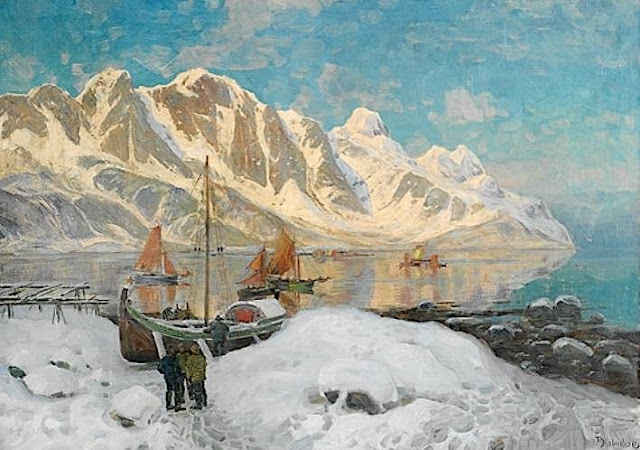MARTIN CHAMBI (1893-1973)
Veronica / Urubamba ( 5,893 m - 19,334 ft)
Peru
In Urubamba Mountain, photo 1930
Veronica (5,893 m - 19,334 ft), also called Willka Weqe ("holy tear"), Huacrahuilki, ("horn pass"), Huacay Huilcay, Wayna Willka, Waqaywillka, Urubamba ("spider's plain"), or Padre Eterno is a ( 5,893 m - 19,334 ft) mountain in the Urubamba mountain range in the Andes of Peru. It is located in the Cusco Region, La Convenciуn Province, Huayopata District, and in the Urubamba Province, Ollantaytambo District northwest of the town of Ollantaytambo.
The Urubamba mountain range extends in a northwesterly direction between 13°08' and 13°17'S and 71°58' and 72°16'W for about 30 km.
The photographer
Martín Chambi Jiménez or Martín Chambi de Coaza, was a photographer, originally from southern Peru. He was one of the first major indigenous Latin American photographers. Recognized for the profound historic and ethnic documentary value of his photographs, he was a prolific portrait photographer in the towns and countryside of the Peruvian Andes. As well as being the leading portrait photographer in Cuzco, Chambi made many landscape photographs, which he sold mainly in the form of postcards, a format he pioneered in Peru.
In 1979, New York's MOMA held a Chambi retrospective, which later traveled to various locations and inspired other international expositions of his work.
Martín Chambi was born into a Quechua-speaking peasant family in one of the poorest regions of Peru, at the end of the nineteenth century. When his father went to work in a Carabaya Province gold mine on a small tributary of the River Inambari, Martin went along. There he had his first contact with photography, learning the rudiments from the photographer of the Santo Domingo Mine near Coaza (owned by the Inca Mining Company of Bradford, Pa). This chance encounter planted the spark that made him seek to support himself as a professional photographer. With that idea in mind, he headed in 1908 to the city of Arequipa, where photography was more developed and where there were established photographers who had taken the time to develop individual photographic styles and impeccable technique.
Chambi initially served as an apprentice in the studio of Max T. Vargas, but after nine years set up his own studio in Sicuani in 1917, publishing his first postcards in November of that year. In 1923 he moved to Cuzco and opened a studio there, photographing both society figures and his indigenous compatriots. During his career, Chambi also travelled the Andes extensively, photographing the landscapes, Inca ruins, and local people.
The archives of Martin Chambi's works are kept in Cuzco in his own house and by the care of his family. Everything is preserved in boxes, left by the photographer, classified and numbered by his own hand. A recent inventory has enumerated about 30,000 photographic plates and more than 12,000 to 15,000 photograph (rolls). Scanning work is in progress to retrieve photographic plates and photos.
"It is wrong to focus too much on the testimonial value of his photos. They have that, indeed, but, in equal measure they express the milieu in which he lived and they show (...) that when he got behind a camera, he became a giant, a true inventor, a veritable force of invention, a recreator of life."
(Mario Vargas Llosa)
Martín Chambi Jiménez or Martín Chambi de Coaza, was a photographer, originally from southern Peru. He was one of the first major indigenous Latin American photographers. Recognized for the profound historic and ethnic documentary value of his photographs, he was a prolific portrait photographer in the towns and countryside of the Peruvian Andes. As well as being the leading portrait photographer in Cuzco, Chambi made many landscape photographs, which he sold mainly in the form of postcards, a format he pioneered in Peru.
In 1979, New York's MOMA held a Chambi retrospective, which later traveled to various locations and inspired other international expositions of his work.
Martín Chambi was born into a Quechua-speaking peasant family in one of the poorest regions of Peru, at the end of the nineteenth century. When his father went to work in a Carabaya Province gold mine on a small tributary of the River Inambari, Martin went along. There he had his first contact with photography, learning the rudiments from the photographer of the Santo Domingo Mine near Coaza (owned by the Inca Mining Company of Bradford, Pa). This chance encounter planted the spark that made him seek to support himself as a professional photographer. With that idea in mind, he headed in 1908 to the city of Arequipa, where photography was more developed and where there were established photographers who had taken the time to develop individual photographic styles and impeccable technique.
Chambi initially served as an apprentice in the studio of Max T. Vargas, but after nine years set up his own studio in Sicuani in 1917, publishing his first postcards in November of that year. In 1923 he moved to Cuzco and opened a studio there, photographing both society figures and his indigenous compatriots. During his career, Chambi also travelled the Andes extensively, photographing the landscapes, Inca ruins, and local people.
The archives of Martin Chambi's works are kept in Cuzco in his own house and by the care of his family. Everything is preserved in boxes, left by the photographer, classified and numbered by his own hand. A recent inventory has enumerated about 30,000 photographic plates and more than 12,000 to 15,000 photograph (rolls). Scanning work is in progress to retrieve photographic plates and photos.
"It is wrong to focus too much on the testimonial value of his photos. They have that, indeed, but, in equal measure they express the milieu in which he lived and they show (...) that when he got behind a camera, he became a giant, a true inventor, a veritable force of invention, a recreator of life."
(Mario Vargas Llosa)





















